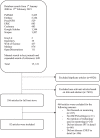Mentoring in palliative medicine in the time of covid-19: a systematic scoping review : Mentoring programs during COVID-19
- PMID: 35545787
- PMCID: PMC9094135
- DOI: 10.1186/s12909-022-03409-4
Mentoring in palliative medicine in the time of covid-19: a systematic scoping review : Mentoring programs during COVID-19
Abstract
Introduction: The redeployment of mentors and restrictions on in-person face-to-face mentoring meetings during the COVID-19 pandemic has compromised mentoring efforts in Palliative Medicine (PM). Seeking to address these gaps, we evaluate the notion of a combined novice, peer-, near-peer and e-mentoring (CNEP) and interprofessional team-based mentoring (IPT) program.
Methods: A Systematic Evidence Based Approach (SEBA) guided systematic scoping review was carried out to study accounts of CNEP and IPT from articles published between 1st January 2000 and 28th February 2021. To enhance trustworthiness, concurrent thematic and content analysis of articles identified from structured database search using terms relating to interprofessional, virtual and peer or near-peer mentoring in medical education were employed to bring together the key elements within included articles.
Results: Fifteen thousand one hundred twenty one abstracts were reviewed, 557 full text articles were evaluated, and 92 articles were included. Four themes and categories were identified and combined using the SEBA's Jigsaw and Funnelling Process to reveal 4 domains - characteristics, mentoring stages, assessment methods, and host organizations. These domains suggest that CNEP's structured virtual and near-peer mentoring process complement IPT's accessible and non-hierarchical approach under the oversight of the host organizations to create a robust mentoring program.
Conclusion: This systematic scoping review forwards an evidence-based framework to guide a CNEP-IPT program. At the same time, more research into the training and assessment methods of mentors, near peers and mentees, the dynamics of mentoring interactions and the longitudinal support of the mentoring relationships and programs should be carried out.
Keywords: E-mentoring; Interprofessional Mentoring; Mentoring; Near-peer mentoring; Palliative Medicine; Peer Mentoring.
© 2022. The Author(s).
Conflict of interest statement
The authors declare that there is no conflict of interest.
References
-
- Choo Hwee P, Hwee Sing K, Yong Hwang MK, Mei HY, A. A qualitative study on the experiences and reflections of junior doctors during a palliative care rotation: perceptions of challenges and lessons learnt. J Pain Symptom Manag. 2020;60(549–558):e1. doi: 10.1016/j.jpainsymman.2020.07.005. - DOI - PubMed
-
- Aslakson R, Kamal A, Gelfman L, et al. “Are you my mentor?” a panel discussion featuring an all-star cast of AAHPM and HPNA mentors and mentees (TH319) J Pain Sympt Manage. 2015;49:342–343. doi: 10.1016/j.jpainsymman.2014.11.054. - DOI
-
- Zhukovsky DS, Eduardo Bruera MR, Rajagopal RG. B07-B Building the future of palliative care: mentoring our people. J Pain Symptom Manage. 2016;52:E18–E19. doi: 10.1016/j.jpainsymman.2016.10.029. - DOI
Publication types
MeSH terms
LinkOut - more resources
Full Text Sources
Medical



